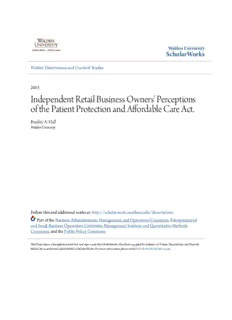
Independent Retail Business Owners' Perceptions of the Patient Protection and Affordable Care Act. PDF
Preview Independent Retail Business Owners' Perceptions of the Patient Protection and Affordable Care Act.
Walden University ScholarWorks Walden Dissertations and Doctoral Studies Walden Dissertations and Doctoral Studies Collection 2015 Independent Retail Business Owners' Perceptions of the Patient Protection and Affordable Care Act. Bradley A. Hall Walden University Follow this and additional works at:https://scholarworks.waldenu.edu/dissertations Part of theBusiness Administration, Management, and Operations Commons,Entrepreneurial and Small Business Operations Commons,Management Sciences and Quantitative Methods Commons, and thePublic Policy Commons This Dissertation is brought to you for free and open access by the Walden Dissertations and Doctoral Studies Collection at ScholarWorks. It has been accepted for inclusion in Walden Dissertations and Doctoral Studies by an authorized administrator of ScholarWorks. For more information, please [email protected]. Walden University College of Management and Technology This is to certify that the doctoral dissertation by Bradley Hall has been found to be complete and satisfactory in all respects, and that any and all revisions required by the review committee have been made. Review Committee Dr. Alen Badal, Committee Chairperson, Management Faculty Dr. Thomas Spencer, Committee Member, Management Faculty Dr. Walter McCollum, University Reviewer, Management Faculty Chief Academic Officer Eric Riedel, Ph.D. Walden University 2015 Abstract Independent Retail Business Owners’ Perceptions of the Patient Protection and Affordable Care Act by Bradley A. Hall MBA, University of Tampa, 1999 BBA, Baylor University, 1992 Dissertation Submitted in Partial Fulfillment of the Requirements for the Degree of Doctor of Philosophy Management Walden University September 2015 Abstract Passage of the Patient Protection and Affordable Care Act (PPACA) in 2010 prompted the question of how independent businesses may react to the employer mandate in the PPACA. The law is based on the theory of managed competition and it is more likely to affect businesses with fewer employees than to affect larger businesses that already offer health insurance. The purpose of this quantitative, pre-experimental study was to examine the strategic responses of independent retail business owners in Hillsborough County, Florida, regarding their perceptions of the employer mandate in the PPACA. Before 2014, there was a great deal of non-peer-reviewed literature in which researchers made predictions about the PPACA and independent business perceptions regarding the new law. To determine independent business owners’ perceptions of and strategies for addressing the PPACA, a random sample of 309 independent retail businesses in Hillsborough County was invited by e-mail to participate in an online survey. The quantitative data were analyzed using descriptive statistics, t tests for hypothesis testing, and chi-square goodness-of-fit analyses to confirm the results without using means. None of the alternative hypotheses were supported, indicating that the PPACA may not have an adverse effect on job creation for independent retail businesses in Hillsborough County. The findings of this study can indirectly promote positive social change by communicating to independent business owners and individuals that healthcare insurance options exist. This question was important to academics and business professionals, because the strategies employed by business owners may affect job creation. Independent Retail Business Owners’ Perceptions of the Patient Protection and Affordable Care Act by Bradley A. Hall MBA, University of Tampa, 1999 BBA, Baylor University, 1992 Dissertation Submitted in Partial Fulfillment of the Requirements for the Degree of Doctor of Philosophy Management Walden University September 2015 Dedication I would like to dedicate this dissertation to my wife, Alicia Hall, for her unwavering support. Whenever I felt like giving up, she reassured me that I would figure out what I needed to do. I could not have done this without her. Acknowledgments I would like to thank Dr. Alen Badal, my dissertation chair, for his support and advice over the years. Thank you for being patient and putting up with me. I also would like to thank Dr. Thomas Spencer. I would not have been able to complete this dissertation without the knowledge of statistics that I gained from him in two advanced statistics courses. Thank you both; you are a credit to your profession. Table of Contents List of Tables ..................................................................................................................... iv List of Figures ......................................................................................................................v Chapter 1: Introduction to the Study ....................................................................................1 Introduction ................................................................................................................1 Background of the Study ............................................................................................2 Problem Statement .....................................................................................................3 Purpose of the Study ..................................................................................................4 Research Questions and Hypotheses ..........................................................................5 Theoretical Framework ..............................................................................................7 Nature of the Study ..................................................................................................10 Definitions of Terms ................................................................................................11 Assumptions .............................................................................................................12 Scope and Delimitations ...........................................................................................12 Limitations ...............................................................................................................13 Significance of the Study .........................................................................................13 Summary and Transition ..........................................................................................14 Chapter 2: Literature Review .............................................................................................17 Introduction ..............................................................................................................17 Background ..............................................................................................................18 The Politics of Healthcare .................................................................................. 18 Massachusetts Healthcare Reform ..................................................................... 21 i Healthcare Reform in the Netherlands ............................................................... 23 Healthcare Reform Comparisons ....................................................................... 25 Patient Projection and Affordable Care Act .............................................................28 Implications ..............................................................................................................31 Healthcare Economics ........................................................................................ 31 Massachusetts Results Vs. PPACA Expectations ....................................................34 Employer Strategies .................................................................................................37 Maintaining the Status Quo ................................................................................ 37 Independent Businesses ...................................................................................... 39 Noninsurance Strategies ..................................................................................... 41 Legal Ramifications .................................................................................................43 Gap in Literature ......................................................................................................48 Summary ..................................................................................................................49 Chapter 3: Research Method ..............................................................................................53 Introduction ..............................................................................................................53 Research Design and Approach ...............................................................................53 Setting and Sample ...................................................................................................55 Data Collection and Analysis ...................................................................................57 Protection of Human Participants ............................................................................61 Summary ..................................................................................................................62 Chapter 4: Results ..............................................................................................................63 Introduction ..............................................................................................................63 ii Pilot Study ................................................................................................................65 Data Collection .........................................................................................................66 Data Analysis ...........................................................................................................67 Treatment .................................................................................................................69 Results ......................................................................................................................70 Comparison to the Literature ....................................................................................83 Summary ..................................................................................................................87 Chapter 5: Interpretations, Implications, and Conclusions ................................................88 Introduction ..............................................................................................................88 Interpretation of Findings .........................................................................................88 Limitations of the Study ...........................................................................................94 Recommendations for Action ...................................................................................95 Recommendations for Further Study .......................................................................99 Implications for Social Change ..............................................................................100 Conclusions ............................................................................................................101 References ........................................................................................................................104 Appendix A: Survey ...............................................................................................119 Appendix B: Introductory E-mail ..........................................................................121 Appendix C: SIC Code Definitions ........................................................................122 Appendix D: Raw Data ..........................................................................................123 iii
Description: